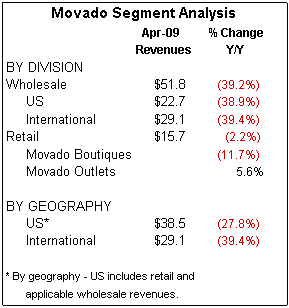IDEX Online Research: Movado Sees Solidifying Demand at Retail
June 25, 09
Despite disappointing sales and increased losses for its first fiscal quarter ended April 2009, Movado management noted that retail sales of its various branded watches appears to have stabilized, and that the lower end brands may be showing a recovery from the extremely weak demand of the fourth quarter of 2008, especially in the U.S. market.
On the other hand, management noted that one of the most challenging markets in the first quarter was Europe, where the recessionary environment was later in coming than in the U.S.
Management also noted that profits for the year could be higher than originally anticipated.
Finally, Movado reconfirmed a trend which has been plaguing the jewelry industry: high-end watches have shown weaker demand than lower-end goods.
The table below summarizes Movado’s major financial trends in the first fiscal quarter ended April 2009.
 |
Quarter Highlights
Highlights from Movado’s first fiscal quarter ended April 2009 include the following:
- Total revenues for the company were down by roughly one-third (33 percent) to $67.6 million from last year’s $101.4 million. While sales were down in all three of the company’s product categories – luxury (Ebel, Concord), accessible luxury (Movado, ESQ) and licensed brands (Coach, Hugo Boss, Juicy Couture, Lacoste, Tommy Hilfiger) – the higher end brands performed worse than the lower end brands.
- The following table summarizes Movado’s sales by geographic area as well as segmenting wholesale and retail sales. Retail division sales in the quarter were $15.7 million, and represented 23 percent of total corporate revenues, up substantially from last year’s 16 percent of total revenues. Like most suppliers, Movado is feeling the impact of the recessionary environment more severely at its manufacturing level than at the retail level.
Unfortunately, Movado does not disclose the actual dollar amount of its retail sales split between its Boutiques and the outlet stores. While the number of stores is nearly equally split between Boutiques (27 units) and outlet units (31 stores), we believe that Boutique sales were roughly one-third of total retail sales, or about $5 million, while outlet sales were roughly $10 million, or about two-thirds of retail sales.

Source: Company reports
- Consumers continued their quest for value in the first quarter. As a result, sales in Movado’s outlet stores were up moderately – +5.6 percent – as the table above illustrates. Further, the company staged compelling in-store sales promotions in its outlet units during the first quarter.
- Unfortunately, sales were down 11.7 percent in the Movado Boutique stores. However, this is a recovery from the prior quarter when sales were down almost 15 percent.
- At the end of the quarter, Movado operated 58 stores – 27 boutiques and 31 outlet units – down 6.5 percent from last year’s 62 units – 30 boutiques and 32 outlets.
- Management noted that the main reason for weak sales was due to retailers not reordering merchandise. Unfortunately, far too many retailers don’t understand the importance of reordering their fast sellers. When those high-turning goods are sold out in their stores, consumers won’t buy less attractive goods that may be left over in the showcases.
- The company’s gross margin fell significantly in the April quarter to 54.8 percent of sales from last year’s 64.2 percent. There were about $4.3 million of liquidation sales in the first quarter. If the liquidation sales are removed, Movado’s gross margin would have been about 59.7 percent, very near the management’s goal of 60+ percent. Further, unfavorable foreign exchange transactions hurt the reported gross margin in the quarter. Finally, in-store sales promotions in the outlet stores helped boost sales, but hurt overall corporate margins.
- Operating costs were 71.2 percent of sales versus last year’s 62.6 percent. Most of the decline was due to lack of sales leverage, despite substantial expense cuts. Marketing costs were about 14 percent of sales; this is below the historic average in the high-teen range.